What Core Can I Say? – Part 2
Last week, I started talking about all the legendary cards in Core Set 2020. I only made it halfway, so today I'll get to the other half.
Kaalia, Zenith Seeker
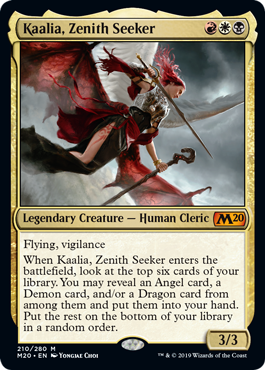
One of the goals of Core Set 2020 was to make a cycle of legendary wedge creatures. Even after 26 years, this is an area that isn't nearly as full as you would expect. For example, as of Core Set 2020, there are only eight red-white-black legendary creatures (and that's more than any other wedge). Core Set 2020 was interested in revisiting one of them, but with a new card design. The choice for red-white-black was Kaalia.
Kaalia showed up in Commander (2011 Edition) and quickly became a fan favorite. She's from the Bant shard of the world of Alara. (You can tell this was made outside of Shards of Alara block, as all the three-color creatures from that block are arc, not wedge.) Her original card for 1RWB was a 2/2 flying creature that had an attack trigger that put an Angel, Demon, or Dragon onto the battlefield from your hand tapped and attacking.
For the new version, the team was interested in coming up with a card that felt similar, but different. They also wanted it to be synergistic with the original version. For starters, they knew it had to interact with Angels, Demons, and Dragons as that was the most memorable thing about her original card. The original version gets them from your hand onto the battlefield. What if the new version helped get them from the library into your hand? As I explained last week, R&D has been leaning toward doing impulses (looking at the top N cards of your library) instead of tutoring (going and getting the card out of your deck) to increase play variance and lessen shuffling.
This new ability was weaker than her old ability, so that let the team a) cost her less (so that she could get the Angel, Demon, or Dragon before needing to have it in your hand), b) up her stats from 2/2 to 3/3, and c) add vigilance (she obviously still had flying).
Kethis, the Hidden Hand
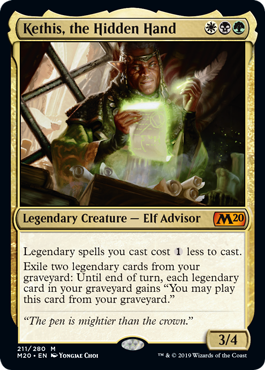
White-black-green had even fewer options for a legendary character than red-white-black, with only five current options. Instead of returning to an existing character, the design team decided to make something new. (Most likely, the design team made a cool design and then talked with the creative team about whether this could be an existing character; with so few choices, I assume the answer had been no.)
Kethis was designed to overlap two themes—"legendary matters" and graveyard. White is the most "legendary matters" color, and black and green are the most graveyard focused. White and black are also the two colors that most often reanimate creatures. My guess is this card started with the second ability. It lets you cast cards of a certain quality from your graveyard, but requires you use that same subset as a resource to be able to do so. We've messed in this space before, but never with legendary spells.
To make this card work, you have to play a high number of legendary spells. To help make that theme work, the card has another ability, one that makes it easier to cast these cards. The cost reduction is also nice in that it synergizes with the second ability as you to play cards from your graveyard. The total package makes a fun card with a very directional build-around constraint.
Kykar, Wind's Fury

Blue-red-white also is a color combination with only five previous options. Like white-black-green, the decision was also made to go with an original character. The key here was to mix and match a bunch of different abilities from each of the colors to create something that cohesively felt like a singular creature. One of the biggest challenges in making three-color designs is getting every color to feel relevant while still making a card that feels as if it's doing a singular thing. Also, the Core Set 2020 design team wanted each three-color card to play into the mechanical theme of those colors. For blue-red-white, that theme was flying.
Kykar ended up having three components. First, it's a 3/3 flier. White and blue are primary in flying. Second, it had a triggered ability that makes a 1/1 flying Spirit whenever you cast a noncreature spell. The trigger is very blue and red. They are the two colors with the highest percentage of spells and have a long history of triggering off of noncreatures being cast. Prowess, for example, was an evergreen ability for numerous years in blue and red. The clever part of this second ability is the creature created is basically a white creature. The 1/1 flying Spirit is a popular white creature token. By combining a blue-red trigger with a white output, it helps the card feel like it's doing one thing while having each color represented.
The third ability is also a clever design. You have a card that creates 1/1 flying Spirits. What else could you do that feels connected to the second ability both in its trigger and its effect? The answer is an activated ability that lets you sacrifice the creature tokens (it's written as Spirit so that it can also work with Spirit cards in your deck as well as the tokens) for an effect that helps you cast other noncreature spells. As red is one of the colors, this lets you do mana production. The mana produced is specifically red to help reinforce that this ability is red in nature. This way, every noncreature spell allows you to make a resource that can both attack and block and provide mana for future spells. It's an elegantly designed card.
Mu Yanling, Sky Dancer

Mono-blue had the opposite problem of mono-white when it came to finding a Planeswalker—there were many options. For example, here's all the Planeswalkers that have appeared on a mono-blue planeswalker card: Jace, Kasmina, Narset, Tamiyo, Teferi, Tezzeret, Will, and Yanling (note that in Chinese, the given name comes second). Kasmina had the same issue as Teyo and The Wanderer, and Will is tied to his twin, Rowan, but the rest were all available options. I believe we went with Mu Yanling because there was an Elemental theme in the set, and her power suite is controlling the elements of air and water. I also believe she wasn't in War of the Spark, because they were interested in using her here and that allowed another blue planeswalker to be in War of the Spark. (We were interested in teasing Kasmina.)
So, what exactly does air and water elemental magic mean in terms of game mechanics? Her original card played more into traditional basic blue abilities (unblockability, card drawing, and taking an extra turn). I think this was done as she was originally designed for an entry-level product made specifically for China. (The planeswalker card was made available for the rest of the world through the Global Series: Jiang Yanggu and Mu Yanling.) Part of what we try to do with planeswalkers is carve up the mechanical space, so that planeswalkers feel different from one another. We were interested in this card better defining her as using elemental magic.
Her first ability plays into air magic. What does controlling air allow you to do? Well, how about impacting the effectiveness of attackers as well as pulling fliers out of the sky. Shrinking (-N/-0) and removing flying are both base-blue abilities. All we needed to do was have the effect last until your next turn, so it can affect any attackers. This ability is a nice plus ability as it helps Yanling defend herself from creatures.
Her second ability played in similar space as Ajani's second ability—it makes a creature token. Yanling controls the air, so we made it an air Elemental. I believe it's an Elemental Bird as that plays into part of her flavor. (Both Yanling and Yanggu were designed to play into Chinese mythology).
The third ability, her ultimate, wanted to be something that tied into her water elemental side. Most of the obvious water-like abilities, such as tapping creatures, are a bit mundane for an ultimate. That's when the design team came up with the idea of caring about Islands in some way. Creatively, Islands also focused on water, so it seemed like a cool fit. The final decision was to grant Islands an ability, something that you'd want to do a lot of times. Making it card draw tied to her original card and made for a splashy ultimate.
Omnath, Locus of the Roil
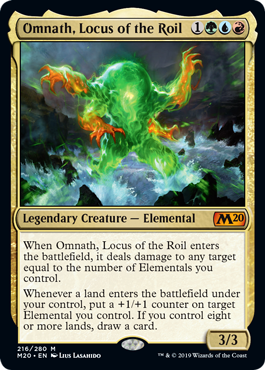
Green-blue-red is another wedge combination with only five previous legendary creatures. This one was able to use an existing character, although, interestingly, one never before in this color combination.
Omnath started as a mono-green card in Worldwake during the original Zendikar block. From the beginning, Omnath was thematically connected to mana. His original card got bigger the more green mana there was in your mana pool. His second incarnation showed up during our return to Zendikar in Battle for Zendikar. Omnath added a color, red, and started interacting with lands (making use of the landfall mechanic). This version of Omnath made 5/5 Elementals and dealt damage whenever it or another Elemental died.
For Core Set 2020, the idea was to bring Omnath back and add yet another color, this time blue. These three colors were the Elemental colors. Omnath already had Elemental synergy, so it seemed like a perfect fit. This card plays heavily into its Elemental theme. Its first ability has an "enters-the-battlefield" effect that scales based on how many Elementals you have. Obviously, it counts itself, so it always does at least 1 damage, but in a well-built deck this card can deal a lot of damage.
The second ability is essentially a landfall effect (although not labeled as such) that helps build up your Elementals. Note that the counters can always be put on Omnath, so even in a non-Elemental deck, Omnath can be played, especially in Limited. For some added oomph, the second ability has a rider that kicks in late game (aka when you have eight or more lands). This helps the card act as a finisher.
Will we eventually get to four-color Omnath? Only time will tell.
Sephara, Sky's Blade
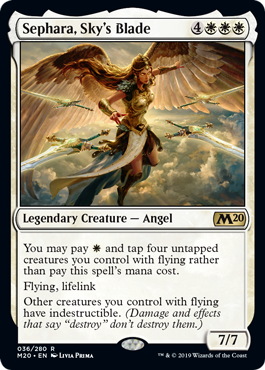
Like Dragons, we've made a lot of legendary Angels. The key for Core Set 2020 was making an Angel that fit the needs of the set. The design team chose to focus Sephara's design on working in a "flying matters" deck. They did this in two ways. First, they gave her an alternate cost that can be paid by tapping fliers. Interestingly, rather than reducing the cost (for instance, tap a flier to reduce the cost by two), they gave her a single alternative cost. This does two things—it requires more dedication to get the payoff, forcing the deck to more commit to the theme, in this case playing fliers, and it allows you to have more colored mana in the mana cost as the alternative cost can reduce the mana by whatever amount it wishes. The alternate cost has a single white mana to make sure you're not sneaking this into a deck without access to white mana.
The second "flying matters" component is Sephara's protective effect. Angels are traditionally flavored as protectors and tend to have abilities that pump or prevent damage to other creatures. In this case, it grants indestructible, but as this is a "flying matters" card, it only protects fliers. Sephara has flying and lifelink as well to further give her an Angel-y feel.
Sorin, Imperious Bloodlord
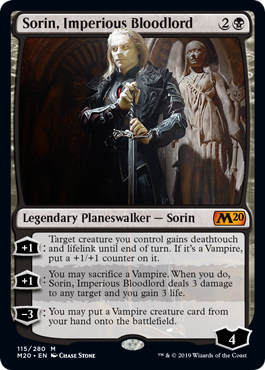
The black Planeswalker slot wasn't quite as pinched as white but had nowhere near as many options as blue. Here are the Planeswalkers that have appeared on a mono-black planeswalker card: Davriel, Liliana, Ob Nixilis, Sorin, and Vraska. Davriel has the issues of the other War of the Spark planeswalkers, and Vraska isn't base-black (her mono-black card was a push to make a Planeswalker Deck work), but the other three were all candidates. In addition, both Ashiok and Kaya are base-black and could probably be done as mono-black planeswalkers in a pinch. We decided that we wanted to give Liliana a break after all the events of War of the Spark, so that left Ob Nixilis and Sorin. From testing, we know that Sorin is pretty popular, so we opted to go with Sorin.
Sorin's shtick is that he's a Vampire Planeswalker, so we allow him to do anything that plays into a Vampire theme. So far, that has included:
- Draining life
- Making Vampires (often with lifelink)
- Boosting your creatures, usually with power boosts or by granting lifelink
- Killing creatures and/or planeswalkers
- Gaining control of players
- Reanimating creatures, bringing them back as Vampires
Also, as this was a core set planeswalker, we wanted a strong theme to build around. A Vampire tribal theme felt like an easy choice. We ended up giving Sorin two positive loyalty abilities. The first grants lifelink and deathtouch (both Vampire-y abilities). It also grants a +1/+1 counter if it targets a Vampire. This is to encourage Vampire tribal.
The second ability gives Sorin a strong draining ability but requires Vampires. This really hammers home that you want to be playing him in a Vampire deck. Again, the offshoot of having so many planeswalkers in Standard is needing to have more planeswalkers be a bit more niche in their design.
The third ability is one Sorin's never done before and not something black does a lot, but as it was Vampire focused, we decided it was acceptable in black. This allows you to get bigger Vampires onto the battlefield faster. The total package is flavorful and really conveys the message that this Sorin wants to be in a Vampire deck.
Vilis, Broker of Blood
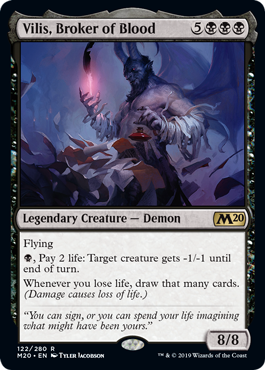
As with Angels and Dragons, we've made a lot of legendary Demons over the years. The key to making a good Demon design is capturing the feeling that the Demon is helping you, but in a way that might come back to haunt you. We want Demon cards to capture the "deal with a demon/devil" flavor. That usually means two things. One, it grants you something you want. Two, that thing comes along with a cost that has the potential to lose you the game. Vilis is a great example of this.
To start with, he's an eight-mana 8/8 flier. That's exciting all by itself. His first ability doesn't read all that great. You can spend one black mana and 2 life to give target creature -1/-1 until end of turn. That's a big cost for little gain, but then Vilis hits you with his last ability. For every point of life lost, you draw a card. That sounds pretty good. Suddenly, the activated ability sounds much better. Pay one black mana and lose 2 life to draw two cards and give a creature -1/-1 for the turn.
This encourages you to build a deck around paying life as a cost, something black does all the time. The problem with paying life is that you only have so much life to spend and having such a great reason to spend it encourages you to push it further than you should. Like a good Demon, Vilis encourages you to do things you often shouldn't with the promise that the power he provides will be enough to win the game before things get out of hand. This in turn makes for dramatic games where you push your luck and have to see if the risk pays off. That's what makes playing Demons so much fun.
Vivien, Arkbow Ranger
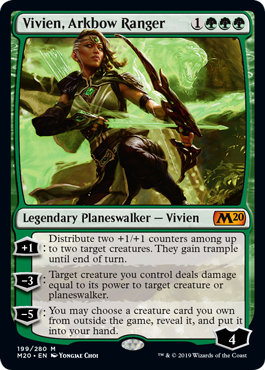
The green planeswalker slot was similar to the black slot. There were options, but not tons of them. There have been six Planeswalkers who've shown up on mono-green planeswalker cards: Arlinn, Freyalise, Garruk, Nissa, Vivien, and Yanggu. Freyalise was dead, and we had other plans for Garruk. Arlinn had some baggage, and we were leaning away from Yanggu as we were already doing Yanling. That left it down to Nissa or Vivien. Nissa had been in more core sets than Vivien, so we decided to go with Vivien. (When planeswalkers first starting showing up in core sets, we always tried to use the same ones but now believe that the diversity of the planeswalkers is part of the fun of the game and a way to help delineate core sets from one another.)
Vivien's shtick is that she has a special bow that lets her fire spirit arrows that bring forth spirit copies of animals from her home plane (which has since been destroyed). As such, her powers tend to be tied to creatures or are bow-themed:
- Boosting creatures, either temporarily or permanently
- Granting abilities to creatures
- Making creatures fight
- Finding creatures (and land) from the top of your library
- Destroying flying creatures
Her first, and only, positive loyalty ability is a simple boosting ability. The one twist is that this version lets you divide up how you hand out the two +1/+1 counters. Her second ability is a Rabid Bite rather than a fight (that is, a one-way fight where only your creature deals damage). Her ultimate is a wish for creature cards (aka going outside the game to get a creature and put it into your hand). While definitely creature themed, Vivien was made less narrow than some of the other planeswalker designs in the set. This tells me Play Design was pushing her a little more for general play in Constructed.
Yarok, the Desecrated
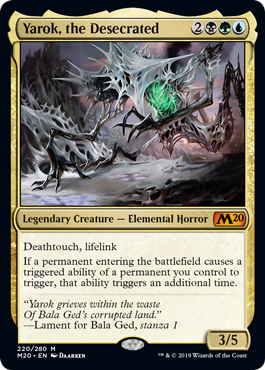
Like the other wedge combinations, black-green-blue doesn't have a lot of previous legendary creatures. Yarok is another new character, apparently from Zendikar according to its flavor text. This card was designed to play into the theme of the three colors in Core Set 2020, in this case enters-the-battlefield effects. The main effect of the creature is basically doubling them, something in both blue and green's parts of the color pie.
To add some black to the card, the creature was given two black abilities, deathtouch and lifelink. From a flavor standpoint, the two reinforce the feel of a life cycle as they reference both life and death. I assume the design team explored the idea of putting a blue keyword on the card (as deathtouch could have been thought of as green's contribution), but blue is a bit shy on creature keywords, and neither flying nor hexproof were things the design team wanted to put onto the card. As a fan of doubling effects, I was excited to see this card in the set.
Legends in Your Own Mind
That's all the legendary cards in Core Set 2020. I hope you all enjoyed the two-week walk through them. As always, I'm interested in any feedback you have, be it on today's column, any of the cards I discussed, or on Core Set 2020 itself. You can email me or contact me through any of my social media accounts (Twitter, Tumblr, and Instagram).
Join me next week when I explain the difference between constraints and defaults.
Until then, may you have fun creating your own stories with Core Set 2020.
#651: War of the Spark Cards, Part 2
#651: War of the Spark Cards, Part 2
This is part two of a five-part series on card-by-card design stories from War of the Spark.
#652: War of the Spark Cards, Part 3
#652: War of the Spark Cards, Part 3
44:41
This is part three of a five-part series on card-by-card design stories from War of the Spark.
- Episode 650 War of the Spark Cards, Part 1
- Episode 649 MagicFest London
- Episode 648 Working on the Road

